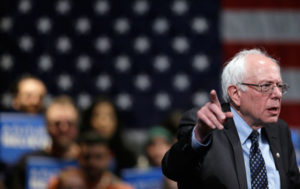New York Times Shows Shameless Bias Toward Hillary Clinton
Bernie Sanders got a little love from The New York Times, but the praise was fleeting A positive Times article on Monday was toned down Tuesday and may have affected primary race voting in five states A positive Times article on Monday was toned down Tuesday, and may have affected primary race voting in five states. After Tuesday's primaries, Hillary Clinton seems headed toward the Democratic nomination. (Lynne Sladky / AP)
After Tuesday's primaries, Hillary Clinton seems headed toward the Democratic nomination. (Lynne Sladky / AP)
The Gray Lady may have to change its slogan from “All the News That’s Fit to Print” to “All the Slanted News That’s Fit to Reprint.”
The New York Times’ editorial board endorsed Hillary Clinton over Bernie Sanders for the Democratic nomination in late January. Now, the paper’s news department isn’t hiding the fact that it is a virtual Clinton mouthpiece, Matt Taibbi from Rolling Stone reports.
According to Taibbi, the Times sandbagged Sanders this week with an egregious editorial affront before Tuesday’s voting in five states — Florida, Illinois, Missouri, North Carolina and Ohio. Close races in Illinois and Missouri were decided by percentage points and low voter turnout. Races appeared to be called for Clinton almost as soon as they began. The total delegate breakdown now is 1,094 for Clinton and 774 for Sanders. This race is still in play.
See our live blog coverage for Super Tuesday III by Truthdig senior editor Kasia Anderson.
On Monday, the Times posted a mostly complimentary piece about the Vermont senator, written by Jennifer Steinhauer and titled “Bernie Sanders Scored Victories for Years Via Legislative Side Doors.”
Taibbi explained:
I took notice of the piece by Jennifer Steinhauer because I wrote essentially the same article nearly 11 years ago. Mine, called “Four Amendments and a Funeral,” was a Rolling Stone feature. Sanders back then was anxious that people know how Congress worked, and also how it didn’t work, so he invited me to tag along for weeks to follow the process of a series of amendments he tried (and mostly succeeded) to pass in the House.
I came to the same conclusions that Steinhauer did initially: that Sanders was skilled at the amendment process and also had a unique ability to reach across the aisle to make deals.
“Sanders is the amendment king of the current House of Representative[s]. Since the Republicans took over Congress in 1995, no other lawmaker… has passed more roll-call amendments (amendments that actually went to a vote on the floor) than Bernie Sanders. He accomplishes this on the one hand by being relentlessly active, and on the other by using his status as an Independent to form left-right coalitions.”
Steinhauer the other day wrote very nearly the same thing. She described how Bernie managed to get a $1.5 billion youth jobs amendment tacked onto an immigration bill through “wheeling and dealing, shaming and cajoling.”
This Times piece was positive enough that Sanders even linked to it on his website. But the goodwill didn’t last long.
A Medium post (“Proof That the New York Times Isn’t Feeling the Bern“) showed that the Times made a number of major revisions online and then changed the headline to this: “Via Legislative Side Doors, Bernie Sanders Won Modest Victories.”
Taibbi noted:
Then [The New York Times] yanked a quote from Bernie’s longtime policy adviser Warren Gunnels that read, “It has been a very successful strategy.”
They then added the following two paragraphs:
“But in his presidential campaign Mr. Sanders is trying to scale up those kinds of proposals as a national agenda, and there is little to draw from his small-ball legislative approach to suggest that he could succeed.
“Mr. Sanders is suddenly promising not just a few stars here and there, but the moon and a good part of the sun, from free college tuition paid for with giant tax hikes to a huge increase in government health care, which has made even liberal Democrats skeptical.”
Taibbi reached out to Steinhauer for comment, and she was diplomatic in her response. “The good part about digital publishing is that we get more things to our readers more quickly but it also means that complete editing sometimes comes at the end of the day,” she told him. “Two or more versions are now pretty common with all our work, as you probably know.”
Editing is part of the news business, but such a public editing display—in which the overall meaning of a piece goes from positive to negative—is uncommon.
How can a newspaper endorse a candidate and be expected to provide honest, unbiased coverage?
Margaret Sullivan, the public editor of The New York Times, has been asking that very question about the Times’ Sanders coverage from the start of his campaign.
Now we know the answer.
Your support matters…Independent journalism is under threat and overshadowed by heavily funded mainstream media.
You can help level the playing field. Become a member.
Your tax-deductible contribution keeps us digging beneath the headlines to give you thought-provoking, investigative reporting and analysis that unearths what's really happening- without compromise.
Give today to support our courageous, independent journalists.






You need to be a supporter to comment.
There are currently no responses to this article.
Be the first to respond.